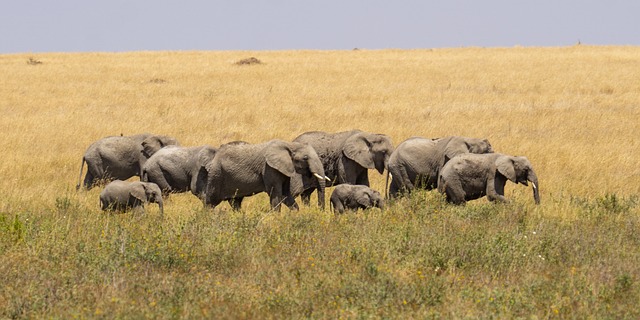
Serengeti National Park, located in northern Tanzania, is one of the most renowned wildlife sanctuaries in the world. Covering approximately 14,750 square kilometers (5,700 square miles), this vast and diverse ecosystem is famous for its incredible wildlife, breathtaking landscapes, and the annual Great Migration. This guide explores the unique features, wildlife, attractions, and practical tips for visiting Serengeti National Park, ensuring an unforgettable safari experience.
The Unique Features of Serengeti National Park
The Great Migration
The Serengeti is perhaps most famous for the Great Migration, an awe-inspiring natural event where over 1.5 million wildebeest, along with hundreds of thousands of zebras and gazelles, migrate in a circular pattern between Tanzania’s Serengeti and Kenya’s Maasai Mara. This journey, driven by the search for fresh grazing and water, is one of the most spectacular wildlife events on the planet.
Diverse Ecosystems
The park’s diverse ecosystems include grassy plains, savannah, woodlands, and riverine forests. This variety of habitats supports a rich array of wildlife, making Serengeti a prime destination for wildlife enthusiasts and photographers.
Historical and Cultural Significance
The name “Serengeti” comes from the Maasai word “Siringet,” which means “endless plains.” The region has been home to the Maasai people for centuries, and their traditional way of life continues to coexist with the park’s natural environment.
Wildlife in Serengeti National Park
The Big Five
Serengeti is home to the Big Five: lions, leopards, elephants, rhinos, and buffalo. These iconic animals are a major draw for safari-goers, and the park provides excellent opportunities to see them in their natural habitat.
Predators
In addition to lions and leopards, the Serengeti is home to cheetahs, hyenas, and jackals. The park’s open plains are ideal for observing these predators in action, particularly during the migration when prey is abundant.
Herbivores
Beyond the migrating wildebeest and zebras, Serengeti hosts a wide variety of herbivores, including giraffes, elands, topis, and impalas. The diverse flora of the park supports these large herbivore populations, which in turn sustain the predators.
Birdlife
Serengeti is a paradise for birdwatchers, with over 500 species recorded. From large birds like ostriches and eagles to colorful species like lilac-breasted rollers and lovebirds, the park offers rich birdwatching opportunities year-round.
Major Attractions and Activities
Game Drives
Game drives are the primary way to explore Serengeti. With the guidance of experienced rangers, visitors can embark on early morning, afternoon, or full-day drives to witness the park’s incredible wildlife.
Hot Air Balloon Safaris
For a unique perspective of the Serengeti, hot air balloon safaris provide breathtaking views of the plains and wildlife. Floating silently above the landscape at dawn, guests can observe the Great Migration, predators on the hunt, and the park’s diverse ecosystems from a bird’s-eye view.
Walking Safaris
Walking safaris offer an intimate experience of the Serengeti’s flora and fauna. Led by knowledgeable guides, these excursions allow visitors to explore areas not accessible by vehicle and learn about the park’s ecosystems up close.
Cultural Visits
Visitors to Serengeti can also engage with the local Maasai communities. Cultural visits provide insight into the traditional Maasai way of life, including their customs, dances, and crafts.
Practical Information for Visitors
Best Time to Visit
The best time to visit Serengeti depends on what you wish to experience:
- June to October: This is the dry season, ideal for game viewing as animals gather around water sources. It’s also the best time to witness the river crossings during the Great Migration.
- November to March: The short rains in November bring fresh grass, attracting the herds back to the Serengeti from the Maasai Mara. Calving season occurs from January to March, offering the chance to see newborn animals and predator interactions.
- April to May: The long rains make some areas difficult to access, but the park is lush and less crowded.
How to Get There
- By Air: The easiest way to reach Serengeti is by flying into Kilimanjaro International Airport (JRO) or Arusha Airport (ARK), followed by a domestic flight to one of the airstrips within the park.
- By Road: Serengeti can also be accessed by road from Arusha, though the journey is long and requires a 4×4 vehicle, especially during the rainy season.
Accommodation
Serengeti offers a range of accommodation options, from luxury lodges to budget campsites:
- Luxury Lodges and Camps: These provide high-end amenities, exceptional service, and prime locations for game viewing. Notable options include Singita Grumeti, Four Seasons Safari Lodge, and Serengeti Migration Camp.
- Mid-Range Lodges and Tented Camps: These offer comfortable accommodations and good value for money. Examples include Kubu Kubu Tented Lodge, Serengeti Sopa Lodge, and Mbalageti Serengeti.
- Budget Campsites: For a more adventurous and affordable experience, there are numerous public and special campsites within the park. These require booking in advance and self-sufficiency in terms of supplies and equipment.
Park Fees and Regulations
Visitors to Serengeti National Park are required to pay entrance fees, which vary depending on nationality and duration of stay. It’s important to respect park regulations, including staying on designated roads, not disturbing wildlife, and following the guidance of park rangers and guides.
Conservation Efforts
Anti-Poaching Initiatives
Serengeti National Park is actively involved in anti-poaching efforts to protect its wildlife, particularly endangered species like rhinos. These initiatives include patrols, community engagement, and collaboration with international organizations.
Community-Based Conservation
The park works closely with local communities to promote sustainable development and conservation. Programs focus on education, livelihood support, and minimizing human-wildlife conflict.
Conclusion
Serengeti National Park is a true gem of Africa, offering unparalleled wildlife experiences, stunning landscapes, and rich cultural heritage. Whether you’re witnessing the dramatic river crossings during the Great Migration, soaring above the plains in a hot air balloon, or engaging with the local Maasai community, Serengeti promises an adventure of a lifetime. With careful planning and respect for the natural environment, a visit to Serengeti will leave you with unforgettable memories and a deep appreciation for one of the world’s most extraordinary ecosystems.
